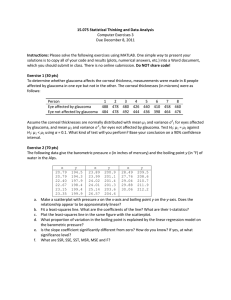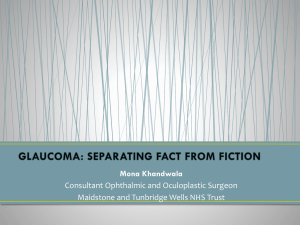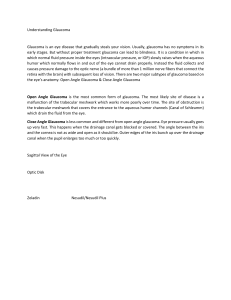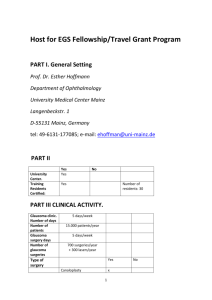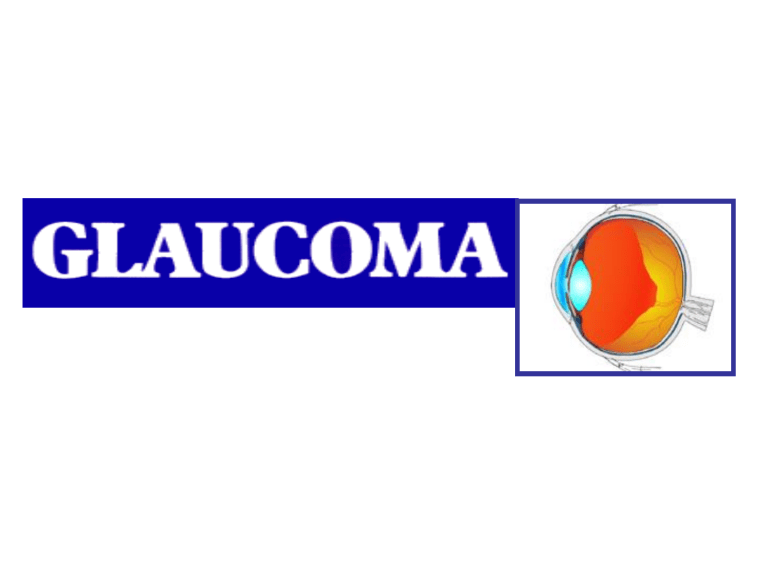
Definition Risk factors Physiology of aqueous secretion Pathogenesis of glaucoma Types of glaucoma Treatment strategy GLAUCOMA Associated with raised intraocular pressure ( I.O.P > 21 mmHg) Characterized by progressive optic nerve damage and visual field loss Risk factors 1. Raised IOP 2. Family H/o glaucoma 3. Myopia 4. Hypertension Types of glaucoma 1. Open angle glaucoma (wide angle, chronic simple) 2. Angle closure glaucoma (narrow angle, acute congestive) Treatment strategy Lowers intra ocular tension by 1. decreasing aqueous humour secretion 2. increasing drainage of aqueous humour Those which increases the outflow of aqueous humour • Cholinergic agoinsts – pilocarpine • Cholinesterase inhibitor – physostigmine , demecarium , echothiophate • Prostaglndin analogues – lantanoprost , unoprostone , travoprost , tafluprost • Rho kinase inhibitor – netarsudi Those which decrease the production of aqueous humor by the ciliary body • Non selective beta adrenergic blockers – timolol • Selective beta 1 – adrenergic blocking agents – betaxolol , careteolol , levobunolol • Non selective adrenergic agonists – adrenaline hydrochloride • Selective alpha 2 adrenergic agonists – apraclonidine , brimonidine • Carbonic anhydrase inhibitor – topical – brinzolamide systemic – acetazolamide • Combination – brinzolamide +brimonidine , timolol +brimonidine ,timolol + dorzolamide Open angle glaucoma Genetically predisposed Degenerative Affects patency of trabecular meshwork Ocular hypotensive drugs to be used 1. β blockers 2. miotics 3. α adrenergic agonists 4. carbonic anhydrase inhibitors Topical β blockers First choice drug Lower IOP by reducing aqueous formation Inhibit cAMP pathway in the ciliary process Highly lipophilic Non-selective Timolol Levobunolol Metipranolol cartiolol Selective Betaxolol Advantages No change in pupil size No induced myopia No headache/brow pain No fluctuation in IOP Convenient Prostaglandins 1st line drug PGF2α derivative Latanoprost, Isopropyl unoprostone Increases uveoscleral outflow Advantages over β blockers Once daily dosing Low systemic side effects Potent IOP lowering effect α adrenergic agonists Clonidine congeners Brimonidine - more α2 selective, highly lipophilic Apraclonidine - highly ionised Reduces aqueous secretion & Increases uveo – scleral outflow Ocular side effects are less Indicated for short & long term use in glaucoma Miotics Increase tone of ciliary muscle & sphincter pupillae trabecular outflow Pilocarpine (0.5%) Preferred miotic Action is rapid & short acting (4 – 6 h) Disadvantages Diminution of vision, spasm of accommodation, brow pain, nausea, diarrhoea, sweating, bronchospasm Ocusert – long acting, once daily Physostigmine (0.1%) - supplement to pilocarpine Potent & long acting miotics (demecarium, echothiophate) - accelerate cataract development Used only as add on therapy Effective in aphakic glaucoma Carbonic anhydrase inhibitors Acetazolamide Reduces aqueous formation by limiting generation of bicarbonate ion in the ciliary epithelium Used to supplement ß blockers and other ocular hypotensive drugs Systemic side effects: paresthesia, anorexia, hypokalemia, acidosis Dorzolamide, Brinzolamide Combination treatment Improves compliance Reduces number of drops to be instilled If Combination treatment fails oral acetazolamide is given followed by surgery Angle closure glaucoma Narrow iridocorneal angle Shallow anterior chamber Emergency condition 1. Topical β blocker: Timolol 0.5% instilled 6-8th hrly 2. Miotic: pilocarpine 1-2% instilled every 10 min;then at long intervals 3. Hypertonic mannitol (20%) or glycerol (10%) 4. Acetazolamide 0.5g iv or oral twice daily 5. Apraclonidine 1% / latanoprost 0.005% / brimonidine 0.2% Alzheimer’s disease First characterized by Dr. Alois Alzheimer (1907) Neurodegenerative disorder characterized by progressive dementia primarily affecting cholinergic neurons in the brain Affects cognition & behaviour Etiology unknown No cure exists Pharmacotherapy aims at reducing symptoms Risk factors Age Prevalence increases with age 65 – 75 yrs: 7% 75 – 84 yrs: 53 % >85 yrs : 40% Sex More common in women Others Head injury, stroke, alcohol, illiterate Cerebroselective Anti-ChE Tacrine : hepatotoxic Rivastigmine : 6 -12 mg/day Donepezil : 5- 10 mg/day Galantamine : 24 mg/day Primary intervention: Non pharmacological & social support Treatment of cognitive symptoms Cholinesterase inhibitors – to be given throughout NMDA receptor antagonist - Memantine Symptomatic approach to psychiatric problems Others Vitamin E Selegiline Estrogen Anti-inflammatory Nicotine • Tobacco plant • MOA – agoinst at cholinergic receptor in brain ,autonomic ganglia and NMJ • Nm – skeletal neuromuscular junction • Nn – CNS and autonomic ganglia • Release – ACh ,NA, DA, 5HT , and beta endorphin in CNS • GH, prolactin and ACTH PHARAMACOLOGICAL ACTIONS • Behavioral effects – stimulation in low dose mesolimbic system • Attention ,learning , reaction time problem solving • Smokers – pleasure relaxation and reduction in anger tension depression and stress • CNS – tremors ,convulsions large dose – depression • CTZ – Vomiting • CVS – increses heart rate due to increased release of catecholamines following stimulation of the sympathetic ganglia and adrenal medulla • GIT – nicotine increases the motility tone and secretion of the GIT TRACT colonic evacuation stimulation of parasympathetic ganglia • Salivation and bronchial secretion • • • • • • Carcinoma of lungs Chronic bronchitis and emphysema COPD IHD PVD GIT disturbances Tobacco dependence • Nicotine receptor agonists – transdermal patches , polacrylate gum/lozenges , nicotine nasal spary ,oral inhaler • Partial agoinst – vareniciline • Doapmine / NA central reuptake inhibitor – bupropion
